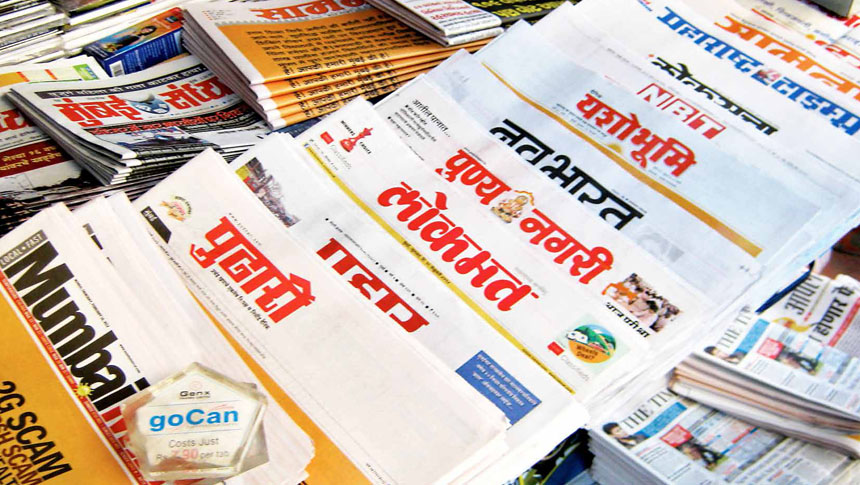The Indian Readership Survey 2017 released earlier in January, after a hiatus of four years. After many controversies about previous survey results, the Readership Studies Council of India (RSCI) and Media Research Users Council (MRUC) have claimed to use enhanced methodology to ensure the veracity of data capture for all quarters.
The sample size for IRS 2017 is reported to be the largest ever at 320, 000 respondents. According to the survey, the number of households has grown by 11% to 29.8 crore in the last 3 years. While the proportion of households with mobile phones has moved up, the proportion of homes with a gas connection has grown even more sharply from 44% in 2014 to 66% in 2017. There has also been a 14% increase in TV ownership since 2011. Literacy rates have also improved, with 39% of Indians (above 12 years of age) reading newspapers. Among these12 years+ individuals, the IRS 2017 has recorded newspaper readership at 104 crore, up from 96 crore in 2014. According to the survey, the launch of new publications has lifted the readership figures. Newspapers added more than 11 crore new readers to touch 40.7 crore in 2017. In fact, the bulk of this new readership has come from rural India. While in the 2014 survey, rural India recorded a total newspaper readership of 14.3 crore, the rural readership of newspapers is 21.4 crore in 2017.

The report also shows that newspaper reading (hard copy) is still a habit among the younger demographic. The readership is 50% in the 16-19 year age group, the highest in any age segment, followed by 42% each in the 12-15 years and 20-29 year age group.
Readership of English dailies has grown by 10% over the last four years and touched 2.8 crore in 2017 as compared to 2.5 crore in the last IRS. Hindi readership stands at 17.6 crore, up 45% from 12.1 crore in 2014. The largest percentage growth has been in Oriya language readership which has grown by 83% to 1.1 crore as compared to 0.6 crore in 2014. Bengali readership grew by 9% to 2.1 crore from 1.9 crore.
Digital newspaper readership has also been incorporated in the latest survey and as per the data, 4% of Indians read newspapers online and this comprises 8% of the urban strata, 11% of 50L+ and 26% of NCCS A1.
Another interesting development has been the reporting of readership for the main issue of newspapers versus their variants. The main and variant editions of a publication are now reported separately in IRS 2017. Variant editions have a share of merely 3% (all India) readership but upon analyzing it city wise, the variant edition shares are quite substantial.
As per the released numbers, the total readership of magazines has almost doubled from 4 crore in 2014 to 7.8 crore in the latest report. Here, the growth has come from the urban areas which added 2.2 crore readers while rural India added 1.7 crore readers. In terms of percentage, a total of 7% of Indians read magazines in 2017 which includes 12% of urban India and 5% of rural India.
In other highlights, the total DTH and digital TV viewership has gone up from 26% to 45%. The survey also reported that Punjab has witnessed the highest growth of more than 50% DTH penetration, followed by Himachal Pradesh with up to 50% and Jammu and Kashmir with more than 40% growth. West Bengal saw the least growth of less than 10%. The percentage of NON-TV media is the highest in Bihar followed by Jharkhand and UP with close to 60%. The survey reveals that while the total radio penetration is just about 19% (all India), the proportion is much higher, state wise. For instance, states such as Manipur, NCT of Delhi, Sikkim, Kerala and Tamil Nadu have more than 30% radio penetration. The top 10 cities of listenership are Delhi, Mumbai, Kolkata, Bengaluru, Chennai, Pune, Hyderabad, Ahmedabad, Lucknow and Kanpur. The lower age groups show a higher index. In terms of cinema penetration, the proportion is less than 10% in all states. Chennai, Hyderabad and Visakhapatnam have the highest number of movie goers, according to IRS 2017.

The survey lists Dainik Jagran as the most read newspaper in India, with 7,03,77,000 readers. This is followed by Hindustan and Amar Ujala in the second and third spots. It is to be noted that there is not a single English daily in the top 10 list. All the top dailies are Hindi broadsheets, barring three regional dailies-the Daily Thanthi, the Lokmat, Malayala Manorama and the Eenadu. Times of India is placed at a distant 11th slot with a total readership of 1,30,47,000. Among English dailies, Hindustan Times and The Hindu English take the 2nd and 3rd spot after Times of India. According to the survey, India Today is the most widely read magazine with 7992,000 readers in 2017.
Well, the increase in total readership is indeed good news for publishers. It is left to be seen how advertisers take advantage of the additional reach and the overall growth.
